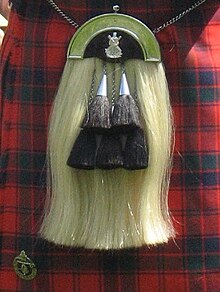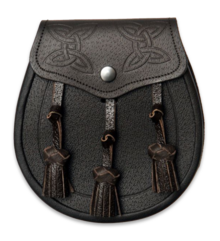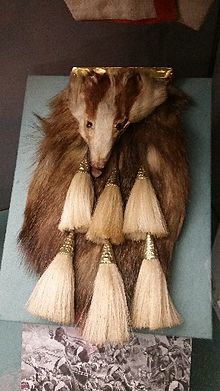Sporran
It is essentially a remnant of the common European medieval belt-pouch, superseded elsewhere as clothing came to have pockets, but continuing in the Scottish Highlands because of the lack of these accessories in traditional dress.
The kilt belt buckle may be very ornate, and contain similar motifs to the sporran cantle and the sgian dubh.
Early sporrans would have been worn suspended from the belt or on either of the hips, rather than hung from a separate strap in front of the wearer.
When driving a car, dancing, playing drums, or engaging in any activity where a heavy pouch might encumber the wearer, the sporran may be turned around the waist to let it hang on the hip in a more casual position.
They are often embossed or hand-tooled with Celtic, thistle, or other designs on the flap and body, and fasten with a stud or hook closure.
They may have sterling or silver-plated cantles trimming the top of the pouch and a fur-covered face with fur or hair tassels.
The top of the cantle may have a set stone, jewel, or emblems such as Saint Andrew, a thistle, Clan, or Masonic symbols.
The body fur of this style is normally a hair hide rather than a loftier material reserved for full dress sporrans.
[citation needed] Today, people do not wear this style very often for standard formal occasions, though it may be worn in historic re-enactments and festivals as a costume accessory.
This style made from horsehide rather than tail hair, are more able to keep with the compact shape and decor of less showy, semi-dress versions.
[citation needed] As sporrans are typically made of animal skin, their production, ownership, and transportation across borders may be regulated by legislation set to control the trade of protected and endangered species.
A 2007 BBC report on legislation introduced by the Scottish Executive stated that sporran owners may need licences to prove that the animals used in construction of their pouch conformed to these regulations.
The main function of sporrans were used as haversack, for each Highlander carried his own provision of oatmeal—eating it if necessary, raw, or mixed with a little cold water—as did Montrose in the dawn before the Battle of Inverlochy.
The official description of the dress sporran is "engraved gilt top, five sided, square edges, with centre in black enamel.
Princess' Coronet on top with her Cypher, the cat and scroll similar to full dress headdress.
The rank and file wore similar ones of black or grey goatskin, but the white tassels had red cords.
These sporrans, unlike the present day ones, had a large roomy pouch, the opening being concealed by the flat top.
Most soldiers were happy when the white sporran was no longer issued as part of the uniform of the Argyll and Sutherland Highlanders.
The sporran has a silver cantle, a border decorated with thistle foliage, and a central coat of arms of the Campbell of Lochnell family; six silver thread tassels; and, a white goat hair covering on a white/light tan leather sporran edged in black leather.







